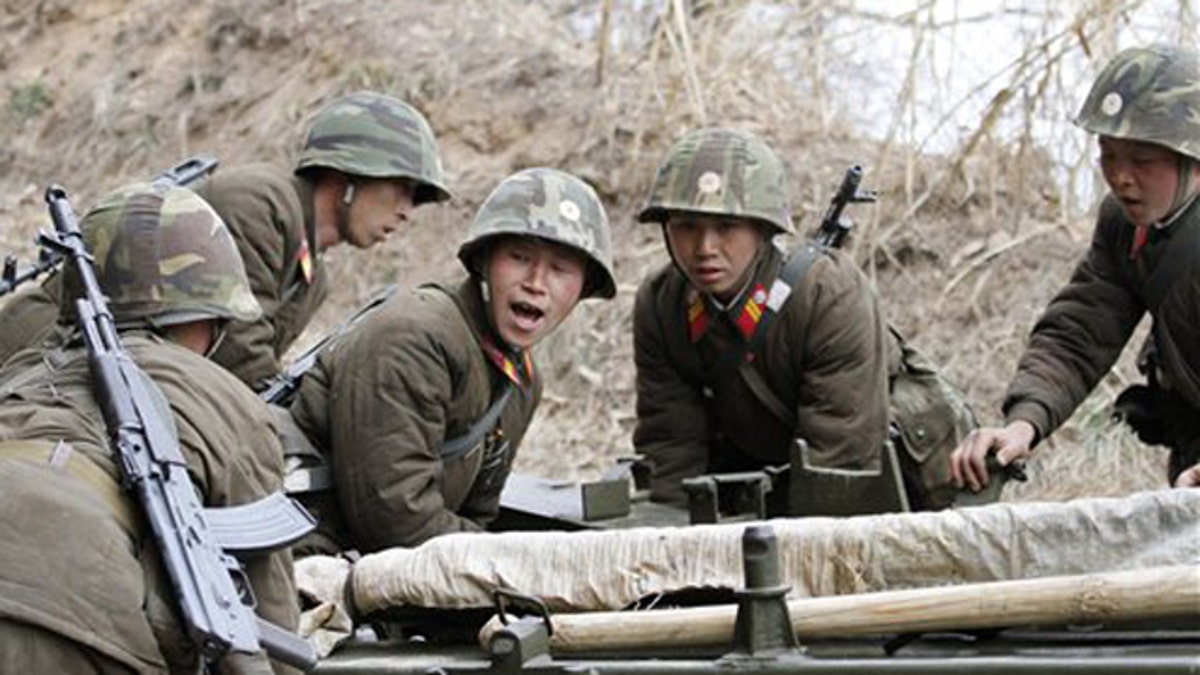
Mar. 5, 2012: North Korean soldiers move equipment during military exercises at a military base on North Korea's southwest coast. (AP)
WASHINGTON – A new report says more than 150,000 North Koreans are incarcerated in a Soviet-style, hidden gulag despite the communist government's denial it holds political prisoners.
The report released Tuesday by the U.S.-based Committee for Human Rights in North Korea is based on interviews with 60 former prisoners and guards. It includes satellite images of what are described as prison labor camps and penitentiaries.
The report documents the alleged incarceration of whole families, including children and grandparents for the "political crimes" of other family members, and infanticide and forced abortions of women prisoners, who illegally crossed into China and got pregnant by men there, and were then forcibly repatriated to North Korea.
The committee, a private group, is holding a conference Tuesday in Washington, timed for Pyongyang's celebrations to mark the centennial of the repressive nation's founder.
U.S. envoy on North Korean human rights, Robert King, is due to address the conference, that comes as the international spotlight shines on the North over its plans to launch a long-range rocket and, according to South Korean intelligence, a third nuclear test.
"It is not just nuclear weapons that have to be dismantled," said Roberta Cohen, chair of the committee's board of directors, "but an entire system of political repression."
The report says the camp system was initially modeled in the 1950s on the Soviet gulag, to punish "wrong thinkers" and those belonging to the "wrong political class" or religious persuasion.
It cites estimates from North Korean state security agency officials who defected to South Korea that the camp system holds between 150,000 and 200,000 people -- out of a total population of around 24 million. It urges North Korea to allow the International Committee of the Red Cross access, and to dismantle the camps.
The 200-page report described different kinds of detention facilities, including penal labor colonies where it says political detainees are imprisoned without judicial process for mostly lifetime sentences in mining, logging or agricultural enterprises.
The labor colonies are enclosed behind barbed wires and electrified fences, mainly in the north and north central mountains of the country, the report says, alleging high rates of death in detention due to systemic mistreatment, torture, execution and malnutrition.
The report alleged provides precise geographical locations of the political prison camps. It says former prisoners were able to identify their former barrack and houses, work sites, execution grounds and other landmarks in the camps via imagery available through Google Earth.
The committee says the report's findings contradict a December 2009 statement by North Korea to the United Nations Human Rights Council that the political prisoner camps do not exist.
Greg Scarlatoiu, the committee's executive director, said that more than 30,000 North Korean defectors have now fled the country -- up from just 3,000 a decade ago -- so Pyonngyang cannot hide the harsh reality of its political prison camps.
